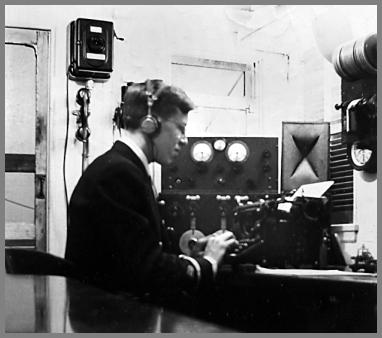
Home Page
Recollections of Ted Phelps, W8TP
Radio gear on the South and North American was 1920s vintage using RMCA 3426 transmitters and "RMCA" IP 501A "regenerative" receivers (below the RME). The IP-501-A receiver was a very strong radiator, and when the ship passed close to a shore station like the Canadian station at Sarnia, Ont. we would often get a request to, "turn the regeneration down." Archivist Note: The book Crystal Clear by Maurice L. Sievers, Vestal Press, 1991, indicates that the IP-501 was really a crystal-set of 1919 design by the Wireless Speciality Apparatus Co. It was re-branded and sold by several other companies including RCA (RMCA). Comparison of the photo of the unit to the photo of the IP-500 (also in the book) seems to indicate that the "regeneration" mentioned above was from a built-in regenerative RF amplifier ahead of the crystal detector.
These vessels also had a small quenched gap spark TX for emergency use only, mounted on the forward bulkhead in the radio cabin (upper right, above the clock). These units were OK in 1939, but were no longer legal in 1940. The bridge telephone is beside the door.
In 1941 I found the radio gear on the
Alabama, the smallest of the three GBL cruise ships, had been replaced
and updated with an RMCA 8010 transmitter for MF only and a modern
superhet receiver (type 8513??).
On all three ships, our traffic went to RMCA stations WCY, Cleveland
OH, WGO, Chicago, IL and independent WLC, Rogers City, MI. Very
infrequently we used RMCA stations WRL, Duluth, MN and WBL, Buffalo,
NY. We also regularly heard WFK, Frankfort, MI (Ann Arbor RR
car-ferries in Lake Michigan)
In 1940 the GL calling frequency was changed from 410 to 500 kHz. We
took advantage of that by sending some passenger traffic at night
directly to WSC (RMCA, Tuckerton, NJ), and got bawled out once by WCY
in 1940 for so doing. They said that our license was for the Great
Lakes only, but that wasn't so, and we ignored their "No No" words!
Canadian coastal stations heard but not worked on MF were VBB, Sault
Ste. Marie, Ont., VBC, Midland, Ont. and VBE, Sarnia, Ont.)
When I was in the U.S.Merchant Marine as Radio Officer aboard SS Alcoa Cadet/ WNEO in February to May 1941, I had with me an Echophone receiver as an auxiliary to the ship's equipment . I'm not sure of the model number but it operated from the ship's power which was 110v DC and it used plug-in coils. I had bought it in NYC's "Radio Row" before I boarded ship in NY. I have an old photo of it sitting on top of the regular RX on the operating desk in the radio shack. I used it to keep in touch with radio ham friends ashore and for other shortwave listening. I had no ham transmitting equipment aboard, but occasionally used the ship's HF transmitter to send radiograms to them. I would pick them up on the Echophone when they called me on schedules. My amateur call at that time was W8MRP. It was a "contrived" way to have QSOs with them.
If I find some additional stuff that may
be of use and interest, I'll send it along. I have met Robert Wilson,
another ex-Georgian Bay Line op by email. There may be a few others
still around and I'll send their names if I find them.
Ted, W8TP
September 2005
Reconstruct the e-mail address: w8tp-at-comcast-dot-net
Back to the Radio Officers Page
